Disability Services Commission Annual Report
Disability Services Commission Annual Report
Disability Services Commission Annual Report
Create successful ePaper yourself
Turn your PDF publications into a flip-book with our unique Google optimized e-Paper software.
4.1 Financial Statements<br />
(n) Amounts Receivable for <strong>Services</strong> (Holding Account)<br />
The <strong>Commission</strong> receives funding on an accrual basis that recognises the full annual cash and non-cash cost of<br />
services. The appropriations are paid partly in cash and partly as an asset (Holding Account receivable) that is<br />
accessible on the emergence of the cash funding requirement to cover items such as leave entitlements and<br />
asset replacement.<br />
See also note 14 ‘Income from State Government’ and note 17 ’Amounts receivable for services’.<br />
(o) Receivables<br />
Receivables are recognised and carried at original invoice amount less an allowance for any uncollectible<br />
amounts (i.e. impairment) .The collectability of receivables is reviewed on an ongoing basis and any receivables<br />
identified as uncollectible are written-off against the allowance account. The allowance for uncollectible amounts<br />
(doubtful debts) is raised when there is objective evidence that the <strong>Commission</strong> will not be able to collect the<br />
debts. The carrying amount is equivalent to fair value as it is due for settlement within 30 days. See note 2(k)<br />
‘Financial Instruments’ and note 16 ‘Receivables’.<br />
(p) Payables<br />
Payables are recognised at the amounts payable when the <strong>Commission</strong> becomes obliged to make future<br />
payments as a result of a purchase of assets or services. The carrying amount is equivalent to fair value, as they<br />
are generally settled within 30 days. See note 2(k) ‘Financial Instruments’ and note 21 ‘Payables’.<br />
(q) Borrowings<br />
All loans are initially recognised at cost, being the fair value of the net proceeds received. Subsequent<br />
measurement is at amortised cost using the effective interest rate method. See note 2(k) ‘Financial Instruments’<br />
and note 22 ‘Borrowings’.<br />
(r) Provisions<br />
Provisions are liabilities of uncertain timing or amount and are recognised where there is a present legal, or<br />
constructive obligation as a result of a past event and when the outflow of resources embodying economic<br />
benefits is probable and a reliable estimate can be made of the amount of the obligation. Provisions are reviewed<br />
at each balance sheet balance sheet date. See note 23 ‘Provisions’<br />
(i) Provisions - Employee Benefits<br />
<strong>Annual</strong> Leave and Long Service Leave<br />
The liability for annual and long service leave expected to be settled within 12 months after the end of the<br />
balance sheet date is recognised and measured at the undiscounted amounts expected to be paid when the<br />
liabilities are settled. <strong>Annual</strong> and long service leave expected to be settled more than 12 months after the<br />
balance sheet date is measured at the present value of amounts expected to be paid when the liabilities are<br />
settled. Leave liabilities are in respect of services provided by employees up to the balance sheet date.<br />
When assessing expected future payments consideration is given to expected future wage and salary levels<br />
including non-salary components such as employer superannuation contributions. In addition, the long<br />
service leave liability also considers the experience of employee departures and periods of service.<br />
The expected future payments are discounted using market yields at the balance sheet date on national<br />
government bonds with terms to maturity that match, as closely as possible, the estimated future cash<br />
outflows.<br />
All annual leave and unconditional long service leave provisions are classified as current liabilities as the<br />
<strong>Commission</strong> does not have an unconditional right to defer settlement of the liability for at least 12 months<br />
after the balance sheet date.<br />
(ii) Provisions – Other<br />
Employment On-Costs<br />
Employment on-costs, including worker’s compensation insurance, are not employee benefits and are<br />
recognised separately as liabilities and expenses when the employment to which they relate has occurred.<br />
Employment on-costs are included as part of ‘Other expenses’ and are not included as part of the<br />
<strong>Commission</strong>’s ‘Employee benefits expense’. The related liability is included in ‘Employment on-costs<br />
provision’. See note 9 ‘Other expenses’ and notes 23 ‘Provisions’.<br />
<strong>Disability</strong> <strong>Services</strong> <strong>Commission</strong> <strong>Annual</strong> <strong>Report</strong> 2007–2008 63


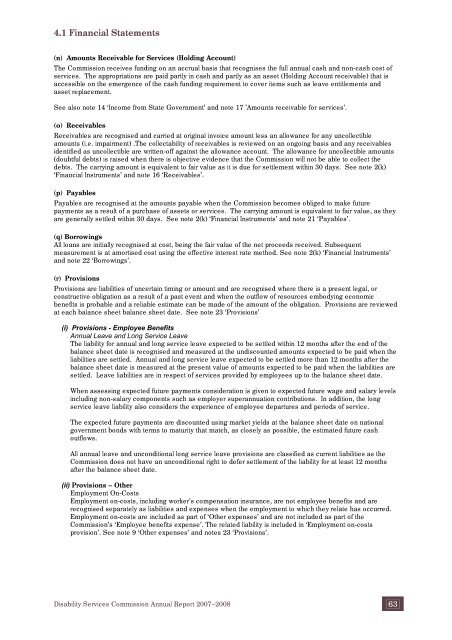

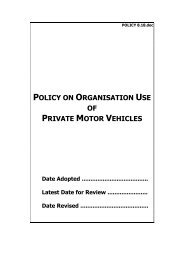
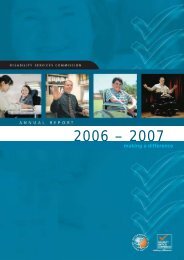

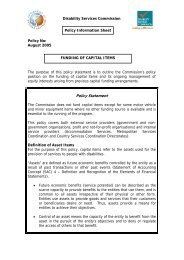
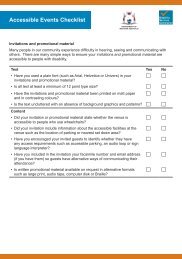
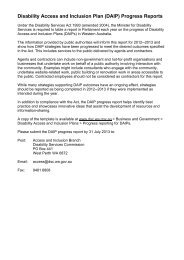
![Heerarka Adeegyada Naafada [PDF 102 kB] - Disability Services ...](https://img.yumpu.com/22096139/1/184x260/heerarka-adeegyada-naafada-pdf-102-kb-disability-services-.jpg?quality=85)
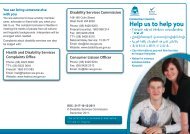
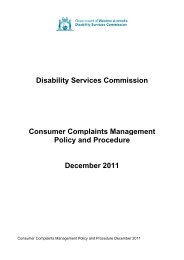

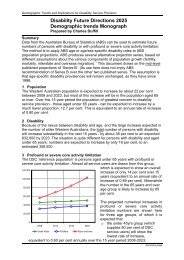

![معايير خدمات الإعاقة [PDF 297 kB] - Disability Services Commission](https://img.yumpu.com/22096120/1/184x260/-pdf-297-kb-disability-services-commission.jpg?quality=85)